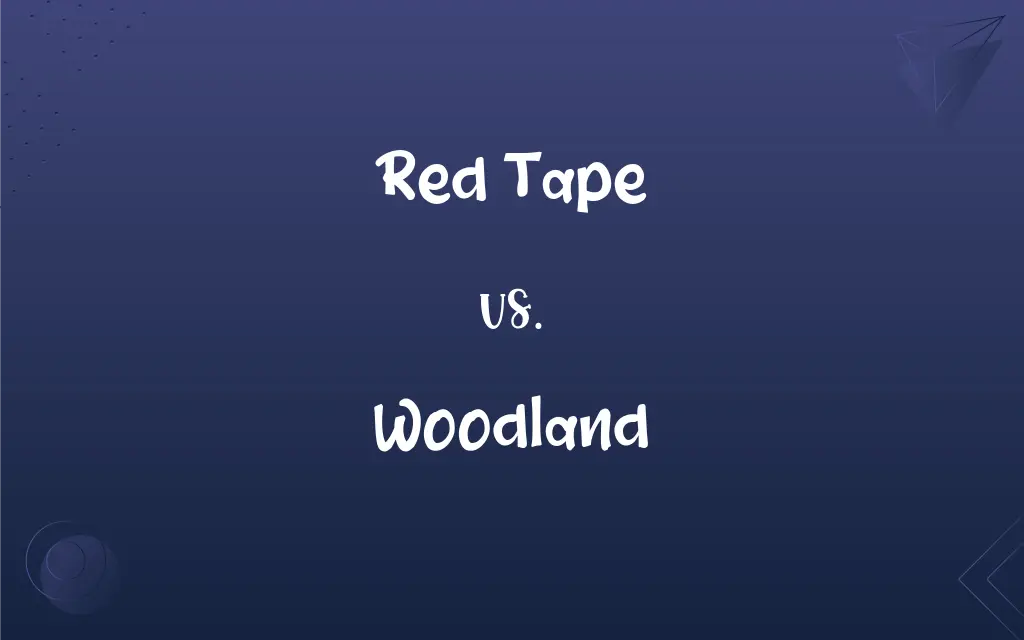Red Tape vs. Woodland: What's the Difference?
Edited by Aimie Carlson || By Janet White || Published on February 16, 2024
Red Tape refers to excessive bureaucracy or adherence to rules and formalities, whereas Woodland denotes an area covered with trees and shrubs.

Key Differences
Red Tape represents the complex procedures and forms often required by governmental or large organizational processes. In contrast, Woodland refers to a natural habitat, typically a smaller forest or a large group of trees.
The term Red Tape is often used to describe frustrating delays caused by bureaucratic procedures, symbolizing obstacles in administrative processes. Woodland, on the other hand, symbolizes nature, tranquility, and a diverse ecosystem of flora and fauna.
Red Tape is associated with man-made systems and can lead to inefficiency and frustration in administration, while Woodland represents a natural environment that is crucial for ecological balance and wildlife habitat.
Red Tape can be seen in various sectors including government, corporate, and legal environments where formalities are strictly followed. Conversely, Woodland areas are important for environmental conservation, recreation, and can be found in rural and sometimes urban areas.
The reduction of Red Tape is often a goal in policy-making to streamline procedures and improve efficiency. In contrast, the preservation and expansion of Woodland areas are environmental objectives to support biodiversity and combat climate change.
ADVERTISEMENT
Comparison Chart
Definition
Excessive bureaucracy and strict procedures
A land area covered with trees and shrubs
Association
Bureaucratic delays, administrative systems
Nature, tranquility, ecological balance
Sector
Government, corporate, legal
Environmental conservation, recreation
Symbolism
Obstacles, inefficiency
Natural beauty, wildlife habitat
Policy Goal
Reduction for efficiency
Preservation for environmental health
ADVERTISEMENT
Red Tape and Woodland Definitions
Red Tape
Excessive adherence to rules and regulations.
Starting a new business can be challenging due to the red tape.
Woodland
A habitat with a significant concentration of trees.
Many wildlife species depend on the woodland for shelter.
Red Tape
Complex and time-consuming administrative procedures.
Obtaining a building permit involved a lot of red tape.
Woodland
A term often used for forested areas in rural settings.
The old castle is surrounded by ancient woodland.
Red Tape
Bureaucratic hurdles often hindering quick decision-making.
The project's progress was slowed down by red tape.
Woodland
An area dominated by trees and underbrush.
The new hiking trail winds through a dense woodland.
Red Tape
Formalities that can lead to inefficiency in organizations.
To improve productivity, the company cut through the red tape.
Woodland
A natural environment crucial for ecological balance.
Conservation efforts are focused on protecting the woodland.
Red Tape
A metaphor for governmental procedural obstacles.
Adopting new technologies in government sectors often faces red tape.
Woodland
Smaller than a forest but larger than a grove.
We picnicked in a small woodland near the river.
Woodland
Of or relating to a Native American culture prevalent throughout much of eastern North America beginning around 1000 BC and lasting especially in northeastern regions until contact with Europeans, characterized by increasing reliance on settled agriculture, by the development of Neolithic crafts and tools, and in certain areas by the building of ceremonial mounds.
Woodland
Of, relating to, or constituting woodland.
FAQs
What is the ecological importance of Woodland?
Woodlands are vital for maintaining biodiversity and ecological balance.
What defines a Woodland?
A Woodland is an area covered with trees and underbrush, smaller than a forest.
Why is Red Tape often criticized?
It's criticized for causing delays and inefficiencies in processes.
Can Red Tape be beneficial?
Yes, in some cases, it ensures thoroughness and compliance with regulations.
How does Woodland differ from a forest?
Woodlands are generally smaller and less dense than forests.
What is Red Tape?
Red Tape refers to excessive bureaucratic procedures and formalities.
Are Woodlands man-made or natural?
They can be either, but are typically natural habitats.
How can Red Tape be reduced?
Through policy reforms and streamlining administrative procedures.
How do Woodlands contribute to the environment?
They provide oxygen, store carbon, and support wildlife.
What sectors are most affected by Red Tape?
Government, business, and legal sectors often face significant Red Tape.
What recreational activities are common in Woodlands?
Hiking, birdwatching, and nature walks are popular in Woodlands.
Is Red Tape a modern phenomenon?
No, it has been a part of bureaucratic systems for centuries.
How does climate change affect Woodlands?
It alters their composition, health, and biodiversity.
Are Woodlands protected by law?
Many Woodlands are protected under environmental laws and regulations.
What are the consequences of excessive Red Tape?
It can lead to frustration, delays, and hindered growth.
Can urban areas have Woodlands?
Yes, urban Woodlands exist, often as part of parks or natural preserves.
Does Red Tape affect small businesses?
Yes, it can pose significant challenges for small business operations.
What wildlife is typically found in Woodlands?
Deer, birds, small mammals, and various insects are common in Woodlands.
What strategies are used to manage Red Tape?
Simplification, digitalization, and regulatory reform are common strategies.
What is the origin of the term Red Tape?
It originates from the red tape used to bind official documents.
About Author
Written by
Janet WhiteJanet White has been an esteemed writer and blogger for Difference Wiki. Holding a Master's degree in Science and Medical Journalism from the prestigious Boston University, she has consistently demonstrated her expertise and passion for her field. When she's not immersed in her work, Janet relishes her time exercising, delving into a good book, and cherishing moments with friends and family.
Edited by
Aimie CarlsonAimie Carlson, holding a master's degree in English literature, is a fervent English language enthusiast. She lends her writing talents to Difference Wiki, a prominent website that specializes in comparisons, offering readers insightful analyses that both captivate and inform.































































